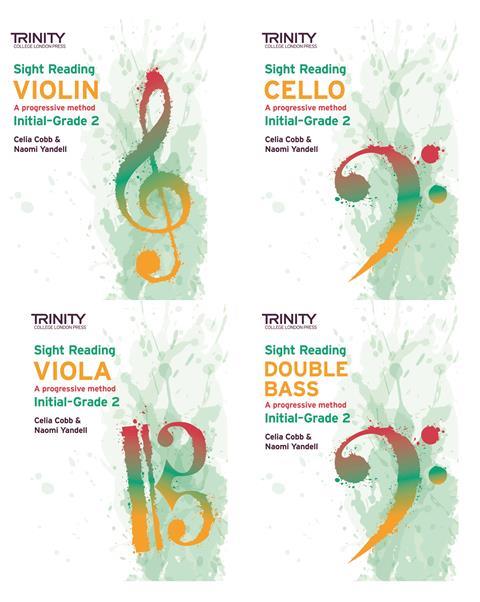Alex Laing reviews a new sightreading method catering for all string players - violin, viola, cello and double bass

Sight Reading Strings: A progressive method
Naomi Yandell, Celia Cobb
Violin
Initial–Grade 2: 72PP ISBN 9780857368539
Grades 3–5: 76PP ISBN 97808557368546
Grades 6–8: 76PP ISBN 97808557368553
Viola
Initial–Grade 2: 72PP ISBN 97808557368560
Grades 3–5: 72PP ISBN 97808557368577
Grades 6–8: 76PP ISBN 97808557368584
Cello
Initial–Grade 2: 68PP ISBN 97808557368591
Grades 3–5: 76PP ISBN 97808557368697
Grades 6–8: 76PP ISBN 97808557368614
Double Bass
Initial–Grade 2: 68PP ISBN 97808557368621
Grades 3–5: 76PP ISBN 97808557368638
Grades 6–8: 80PP ISBN 97808557368645
Trinity College London Press
£14 each
Celia Cobb and Naomi Yandell have produced a comprehensive, progressive method to develop sightreading skills for all four of the bowed stringed instruments. The stated purpose is to help students to prepare for Trinity College London’s instrumental graded music exams. While this preparation is clearly central to the volumes, there is more to appreciate in addition, and the method will be useful irrespective of any exam timetable.
There are three books for each instrument: Initial to Grade 2; Grades 3–5 and Grades 6–8. The music used is identical for each instrument, making it ideal for any teacher wishing to work on sightreading in groups, or as a string orchestra, with the bonus of developing ensemble skills at the same time.
Every grade is divided into ten lessons, each one neatly occupying a double page. The lesson sets out a specific aim, such as tackling a new time signature, and is followed by exercises to develop and use this new skill. Cobb and Yandell are always encouraging the reader to ‘Think Before You Play’. They ask questions about aspects of or patterns in the music, reinforcing the learning, and helping pupils find a sense of welcome familiarity. Every lesson concludes with a sightreading duet. At the end of each set of ten lessons, a number of specimen Trinity tests allow students to measure their progress against the standard of music they might expect for sightreading in the exam.
As one would expect from these distinguished educators, Cobb and Yandell are well versed in the varying demands of the different stringed instruments at each exam grade level. At Grade 2, a cellist will need to recognise where to use the second finger in C major on the A string, while violinists need only ‘standard fingering’ at the same stage.
In the higher grades (6–8), Cobb and Yandell include adaptations of ‘real music’ in their duets. Pleasingly, a violist or cellist might find themselves reading a version of the first violin part of Eine kleine Nachtmusik, while a violinist might find themselves learning the harmony of the Bach E major Violin Concerto.
All of this means that while a student is preparing for an exam, they are also adding analytical and musical skills at the same time. Even if a teacher does not use Trinity exams with their students, these volumes are an excellent educational resource.
ALEX LAING











































No comments yet